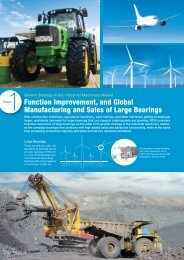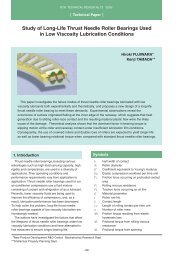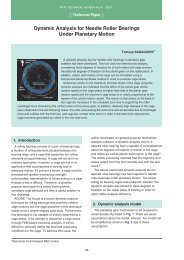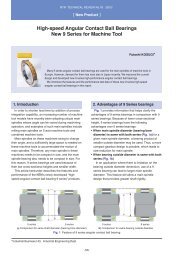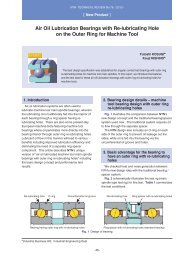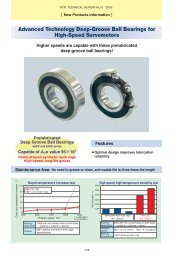Special Issue; Products for Industrial Machinery - NTN
Special Issue; Products for Industrial Machinery - NTN
Special Issue; Products for Industrial Machinery - NTN
Create successful ePaper yourself
Turn your PDF publications into a flip-book with our unique Google optimized e-Paper software.
Trends in Recent Machine Tool Technologies<br />
hard-to-cut materials as well as in high-speed, highefficiency<br />
machining of aluminum materials <strong>for</strong><br />
aviation purposes. Generally, chatter vibration is<br />
avoided by reducing the depths of cuts and cutting<br />
speeds (low-speed stability), but it is possible to avoid<br />
chatter vibration by increasing spindle speed. This fact<br />
was already known from research done in the 1960’s.<br />
Since high-speed spindles boasting this ability were<br />
not available in those days, however, this fact was<br />
regarded simply as a theoretical possibility. In the<br />
mathematical field, it was also difficult theoretically to<br />
handle chatter vibration in milling processes, including<br />
end milling. Notwithstanding, Prof. Y. Altintas et. al.<br />
obtained results <strong>for</strong> stability graphs such as the one<br />
shown in Fig. 1. This graph shows that chatter<br />
vibration does not occur in the region of depths cut<br />
below the stability lobes relative to spindle speeds on<br />
the horizontal axis. Though detailed discussion of this<br />
finding 2) is omitted in this paper, the underlying<br />
principle of chatter vibration can be understood from<br />
the expressions and diagrams given to the right of this<br />
graph. Variations in chip thickness are caused by<br />
differences between the roughness of the finished<br />
surface generated by the immediately previous<br />
revolution of the main spindle or by an immediately<br />
previous cutting edge and the roughness of the<br />
finished surface currently generated by the current<br />
cutting edge. This variation in chip thickness<br />
contributes to variation in the cutting <strong>for</strong>ce and<br />
contributes to continuing vibration. If we can run the<br />
main spindle at a higher speed that is equivalent to<br />
the vibration frequency, then the difference between<br />
the phase of vibration resulting from the immediately<br />
previous revolution and the phase of vibration deriving<br />
from the current revolution can be effectively<br />
controlled, thereby eliminating variations caused by<br />
chip thickness. If such a condition is realized, chatter<br />
vibration will not occur even with greater cut depths.<br />
Utilizing this principle, high-speed, high-efficiency<br />
cutting has been implemented <strong>for</strong> aircraft components<br />
made of aluminum and other materials. Given this,<br />
there has been mounting interest in the dynamic<br />
characteristics of a main spindle system that includes<br />
a main spindle, chuck and tools. As a result, the<br />
interrelation of bearings and other design factors with<br />
the dynamic characteristics of the main spindle and<br />
main spindle system has been clarified both<br />
theoretically and experimentally, and this achievement<br />
has been applied to the design of main spindles.<br />
Recently, various software packages are also being<br />
used frequently <strong>for</strong> analysis and design. The<br />
theoretical study of main spindle designs will become<br />
increasingly important.<br />
3. Combined Multifunctional Machine Tools<br />
In addition to high-speed, high-efficiency, cuttingcapable<br />
machine tools, research on machine tools is<br />
currently focused on combined multifunctional<br />
machine tools, including 5-axis machining centers and<br />
combined multifunctional turning centers. The<br />
background and advantages of combined<br />
multifunctional machine tools are summarized in<br />
Table 2. Combined multifunctional machine tools can<br />
be roughly categorized into turning centers (TC) that<br />
have been developed from lathes and machining<br />
centers (MC) that started as milling machines.<br />
A portion of the investigations into machining<br />
applications with combined machine tools based on<br />
lathes is illustrated in Fig. 2. In addition to machining<br />
of bores, outer circumferences and end faces, certain<br />
applications are executed <strong>for</strong> slope machining and<br />
Real Part [m/N]<br />
2<br />
1<br />
0<br />
-1<br />
-2<br />
-1<br />
G min <br />
4k<br />
2k=Dynamic Stiffness<br />
K tc=Cutting Coefficient<br />
n=60/T<br />
T=<br />
2K<br />
c<br />
lm [jc]<br />
=32tan -1<br />
Re [ c]<br />
0<br />
500 1000 1500 2000 2500 3000 3500 4000<br />
Frequency[Hz]<br />
Axial depth of cut [mm]<br />
5<br />
4<br />
3<br />
2<br />
1<br />
Stabiliy Lobes<br />
0 0 2000 4000 6000 8000 10000 12000 14000 16000<br />
Spindle speed [rev/min]<br />
a lim =<br />
-1<br />
2K tcG()<br />
Fig. 1 Stability chart of regenerative chatter vibration (Y. Altintas)<br />
180˚<br />
Chip<br />
-1 2k<br />
a crit = =<br />
2K tc -1 K tc<br />
4k<br />
-3-



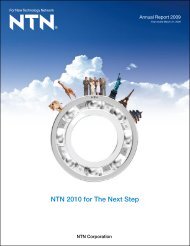
![[New Product] Unit Products for Office Equipment - NTN](https://img.yumpu.com/27154451/1/184x260/new-product-unit-products-for-office-equipment-ntn.jpg?quality=85)
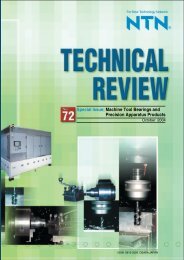
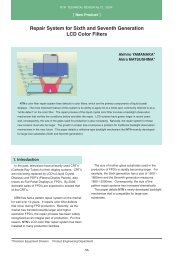
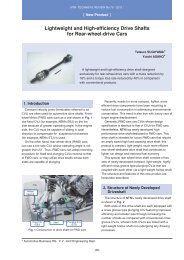
![[New Product] Development of Oil-impregnated Sintered ... - NTN](https://img.yumpu.com/27154427/1/184x260/new-product-development-of-oil-impregnated-sintered-ntn.jpg?quality=85)

